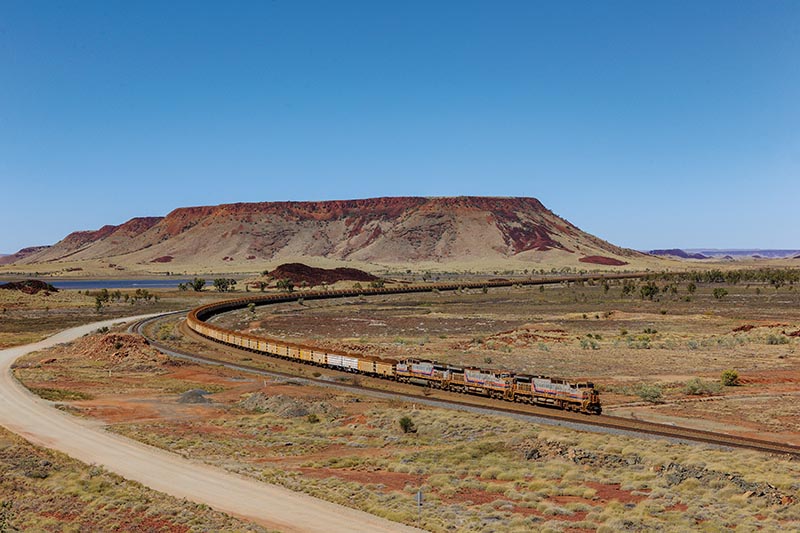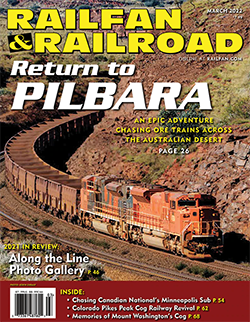 By Kevin EuDaly/photos by the author
By Kevin EuDaly/photos by the author
There is nothing about railfanning the Pilbara that’s easy, and it starts with getting there. After the magic trip in 2011 (see “The Pilbara: Magic in 2011” in March 2021 Railfan & Railroad), the years slipped by, and though Mel Wilson, John Benson, and I often talked about a return, we had a hard time fitting it into our often hectic schedules. John made it back solo several times, but I was busy with White River Productions and Mel was busy running trains for BNSF Railway. Then favorable circumstances presented themselves for a return in 2018. Mel went to work for Lake Superior & Ishpeming, and between jobs got the necessary time off for a trip thanks to the great folks at LS&I.
Like the previous trip, this one was also filled with its share of challenges, and it began before we even left Kansas City, Mo. Mel and I met at the airport, and while unloading his gear Mel realized he’d left his camera bag at home, almost an hour from the airport. Oh, boy. Fortunately, I’d put time between our flight on Southwest Airlines to Los Angeles (where we planned to meet up with John Benson) and our departure to Melbourne on United Airlines — a lot of time, like, 10 hours.
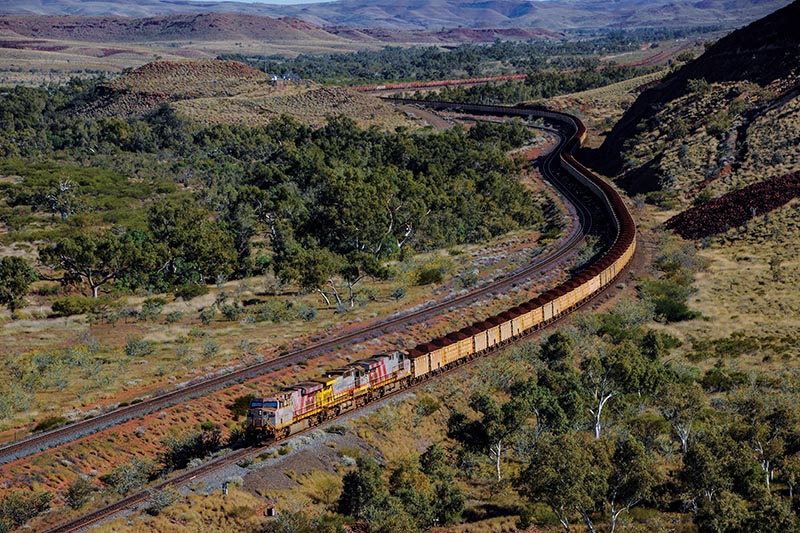
ABOVE, Day 1, August 6: Rio Tinto ES44DCi locomotives 8130 and 8180 bracket Pilbara Rail Dash 9-44CW 9429 on northbound loads at Greenpool at 3:14pm. A roadside sign calls this “Jacob’s Gully.” They’ve just met northbound empties which can be seen moving away in the distance. The ends of both trains are behind the hill to the left. This is on the former Robe River line between Cape Lambert and Western Creek Junction.
Meanwhile, Mel’s children, April and Nick, tag-teamed the delivery of the errant camera bag — Nick rushed to Mel’s house in Greenwood, picked up the bag, and dashed north to meet April, who would run it the rest of the way to the airport. We were all set in the airport, and our bags all went on the plane. With Mel still in the terminal, I watched from my seat — next to the empty one where he should have been sitting — as they closed the door of the plane and texted Mel, “They just closed the door.”
Mel, camera bag now in hand, quickly texted back, “I just watched them close the door.”
So off to Los Angeles I went, sans Mel, but with Mel’s checked bags on the plane. Mel caught a later flight and arrived in plenty of time, but in the meantime I was his packhorse, hauling his bags along with my bag and my carry-on across the parking lot from the Southwest terminal to the United one. We weren’t even across the Pacific Ocean yet and the challenge of the Pilbara was already upon us. Truthfully, the Pilbara’s resistance reaches a long, long way.
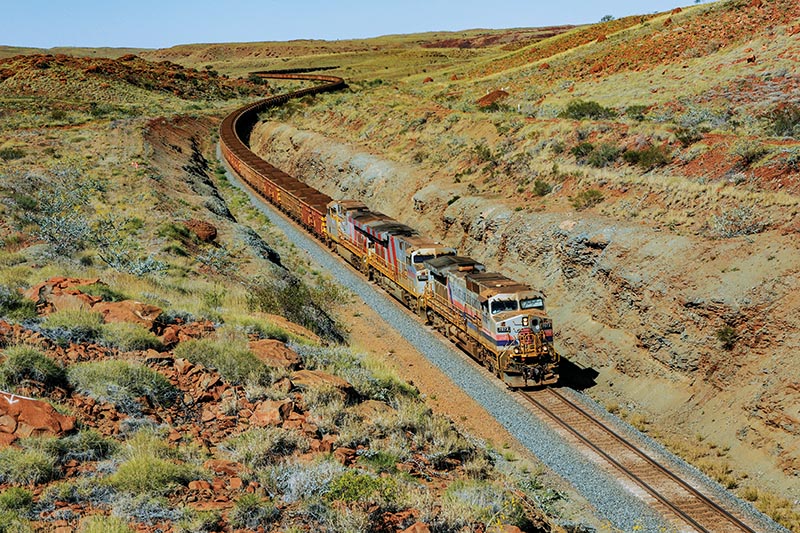
ABOVE, Day 2, August 7: Rio Tinto Hamersley Iron-lettered Dash 9-44CW 7087 leads northbound loads through Gecko at 11:43am. Trailing are Rio Tinto-lettered 8198 and 8193, both ES44DCi locomotives.
Working off our previous experience, we arranged this trip entirely differently from the one in 2011. We opted to fly all the way to Port Hedland in one very long day by flying to Melbourne, connecting to Perth, then to Port Hedland — a total travel distance of 11,802 miles. After the long drive from Perth in 2011 where we struck a kangaroo in the middle of nowhere (hence known as the “Roo Incident”), John vowed to never drive to the Pilbara again. Once my packhorse duties were over, I met up with John in Los Angeles and before long Mel arrived; things seemed to be falling into place. From the time I left my home in Bucklin, Mo., to our arrival in Port Hedland, more than 44 1/2 hours had ticked by. The Pilbara is completely on the other side of the world, and just getting there is a challenge.
This trip was no-nonsense (other than the errant camera bag) right from the start. We rented a mine-compliant “ute” (Aussie for “utility vehicle”) that comes with two spares, rooftop strobe lights, a tall visibility flag, and radios for use in the mines — after 2011 we vowed never again to take a regular rental car into the Pilbara. The downside is the cost — there are no free kilometers on rental cars in the Pilbara, and they add up fast. We spent the night in Port Hedland, got up early on August 6, and drove straight to Roebourne and up toward Cooya Pooya Pass on Rio Tinto, where we recorded our first shots of northbound loads at Harding at 7:18am. It was exhilarating to be in the Pilbara again.
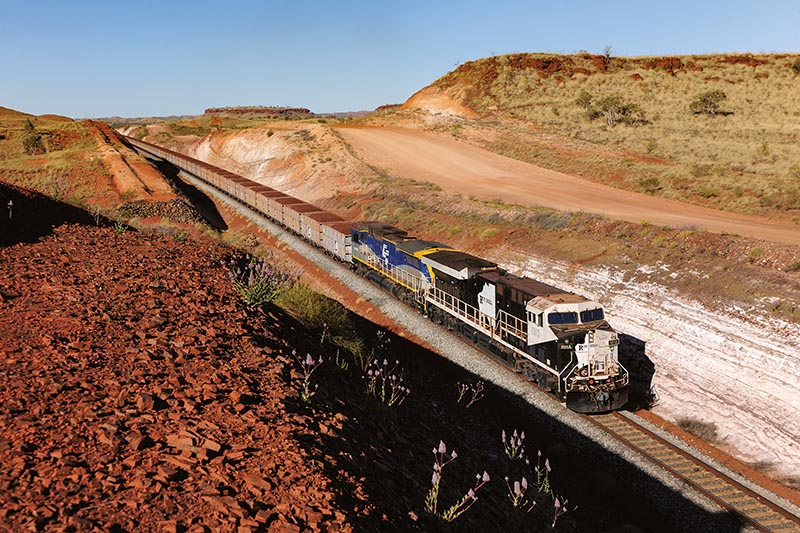
ABOVE, Day 9, August 14: After our flat tire we were reluctant to keep exploring farther south on Roy Hill. We got as far as the BC Iron Haul Road and turned back, knowing a load was probably getting close. ES44DCi 1013 leads CM40-8M 4305 on northbound loads north of Taiwan at 3:38pm. The CM40-8M was built as Chesapeake & Ohio Alco C-630 2103, which went to Robe River as 9420 before going to CFCLA in 2012. Though rebuilt as a GE from the frame up by Goninan, the round Alco fuel tank and Alco trucks are recognizable. The spectacular white cuts are made up almost entirely of quartz.
Between the trips, this route had been “duplicated,” Australian for double-tracked. A lot of places that were single track in 2011 were duplicated by 2018 — iron ore railroading in the Pilbara has seen massive growth for many years, and in seven years a lot changes. Though we didn’t start out with a flat on this trip, John had two equipment malfunctions. The first was early in the day when he dropped his film camera and it quit. After a few minutes of fiddling with it he smacked it on a rock and it started working again — the beauty of analog technology. Then early in the “arvo” (afternoon) while climbing a rocky hillside north of Harding, he had a blowout on one of his boots and had to climb back down with no sole in one boot. By late afternoon both Mel and I were sunburned — more sunscreen required. John also slipped once and sat down hard and had a sore tailbone for several days. Once again, the Pilbara gods were testing us, and it was still Day 1!
We had another incident on the first day that’s worth noting. One of the changes between 2011 and 2018 was that the iron ore roads of the Pilbara started testing and then operating driverless trains, especially Rio Tinto. The trains have no onboard crew but instead are operated remotely from headquarters in Perth, nearly a thousand miles to the south. As a result, Rio Tinto installed motion sensors between the gates at major road crossings as a safety precaution. Because the trains are equipped with electronic brakes, they can stop very quickly, and if the motion sensors detect motion between the gates after the gates have gone down, the train comes to a stop.
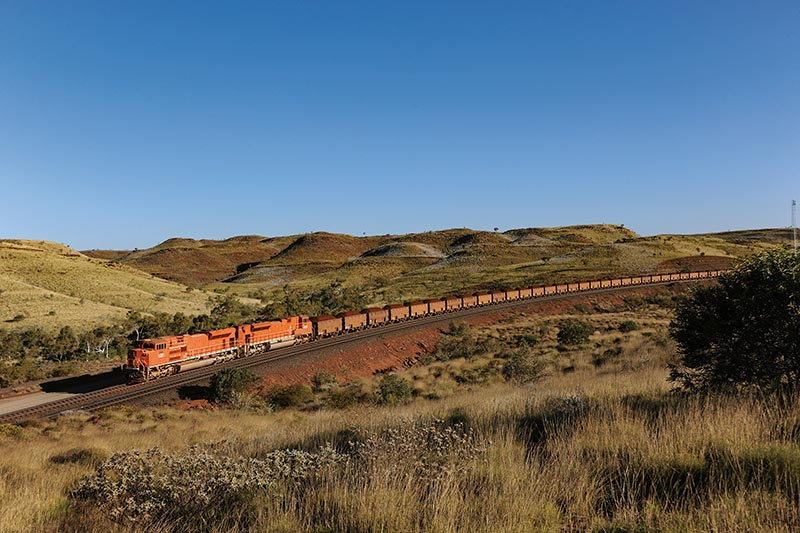
ABOVE, Day 10, August 15: BHP has 10 locomotives in the “BNSF orange” scheme, 4324–4333, which were built for BNSF but diverted to BHP while still at EMD. Getting one on the point is a bonus, but getting a pair is sweet. Powering this northbound loaded train are SD70ACes 4331 and 4328 at Garden at 4:08pm as we’re working our way back to Auski. Astoundingly, that same afternoon had solid orange locomotives leading two other trains.
Late in the day, we were driving north at the highway crossing north of Harding and saw a southbound headlight. We pulled over and set up for a photograph. For some then-unknown reason the driverless train, bearing down on the crossing at perhaps 40 mph, suddenly applied the brakes and stopped right at the crossing. It came to a complete stop in about 600 feet — electronic brakes are impressive. We looked at each other, shrugged, and departed. We listened on the scanner as they sent a roving crewman to take a look and restart the train. Apparently, the system was still in the testing phase and they’d had a lot of false trips, including kangaroos hopping between the gates or things blowing in the wind.
As usual, Day 1 in the Pilbara came with its challenges, and it wasn’t over yet. We checked into the EconoLodge in Karratha and they had a spread of food available that was just about gone. While grabbing what was left, John forgot a camera bag, and when we arrived in our room he realized he had his cameras but not the bag with all his film. The food room was locked, and a frantic phone call later, the EconoLodge folks said they’d locked it because John’s bag was in there. He breathed a huge sigh of relief when he was able to retrieve his bag. John ran an application on his phone that measures distance walked and height climbed, and on Day 1 it was 3.5 miles and 24 stories climbed…


